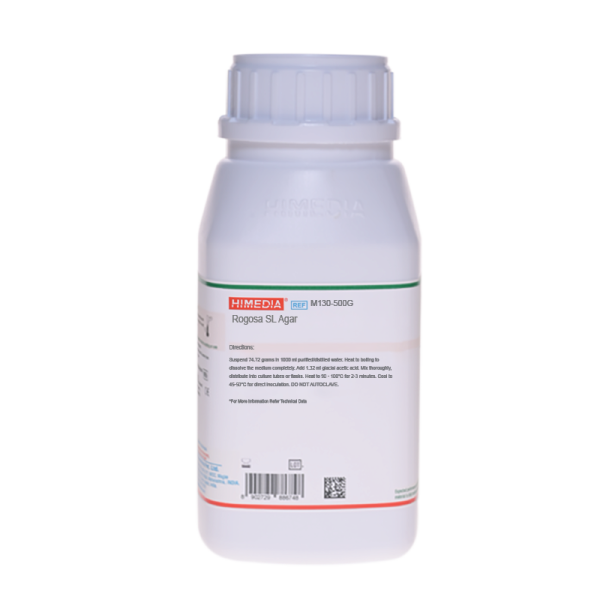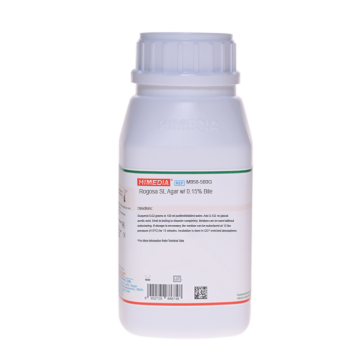 Your enquiry has been submitted
Your enquiry has been submitted
Rogosa SL Agar
Intended Use:
Recommended for selective cultivation of oral and faecal Lactobacilli.
Composition**
| Ingredients | g/L |
|---|---|
| Tryptose | 10.000 |
| Yeast extract | 5.000 |
| Dextrose (Glucose) | 10.000 |
| Arabinose | 5.000 |
| Saccharose (Sucrose) | 5.000 |
| Sodium acetate | 15.000 |
| Ammonium citrate | 2.000 |
| Potassium dihydrogen phosphate | 6.000 |
| Magnesium sulphate | 0.570 |
| Manganese sulphate | 0.120 |
| Ferrous sulphate | 0.030 |
| Polysorbate 80 (Tween 80) | 1.000 |
| Agar | 15.000 |
Final pH (at 25°C): 5.4±0.2
**Formula adjusted, standardized to suit performance parameters
Directions
Suspend 74.72 grams in 1000 ml purified / distilled water. Heat to boiling to dissolve the medium completely. Add 1.32 ml glacial acetic acid. Mix thoroughly, distribute into culture tubes or flasks. Heat to 90 - 100°C for 2-3 minutes. Cool to 45-50°C for direct inoculation. DO NOT AUTOCLAVE.
Principle And Interpretation
Rogosa SL Agar also known as RMW Agar, is a modification of the media formulated by Rogosa, Mitchell and Wiseman (1,2). This media is used for isolation, enumeration and identification of Lactobacilli from foodstuffs and clinical specimens (3,4). Accompanying bacterial flora is suppressed due to the low pH of the medium and also because of the high sodium acetate concentration.
Tryptose and yeast extract provide nitrogenous compounds, sulphur, trace elements and vitamin B complex, essential for growth of Lactobacilli. Dextrose, arabinose and saccharose are the fermentable carbohydrates. Polysorbate 80 is the source of fatty acids. Ammonium citrate and Sodium acetate inhibit moulds, Streptococci and many other organisms. Monopotassium phosphate provides buffering capability. Magnesium sulphate, manganese sulphate and ferrous sulphate are sources of inorganic ions. Low pH of the medium and addition of acetic acid makes the medium selective for Lactobacilli inhibiting other bacterial flora (3).
It is recommended that the plates should be incubated at 30°C for 5 days or at 37°C for 3 days in an atmosphere of 95% hydrogen and 5% carbon dioxide (5). If this is not possible, overlay the inoculated plates with a second layer of the agar before incubation. High acetate concentration and acidic pH suppress many strains of other lactic acid bacteria. All colonies should be checked by gram staining and by catalase test before further identification. The salt in the formulation makes the medium unsuitable for isolation of dairy Lactobacilli. e.g. L. lactis, L. bulgaricus and L. helveticus (3,2).
Type of specimen
Clinical samples - Saliva, faeces, etc., Foodstuffs
Specimen Collection and Handling:
For clinical samples follow appropriate techniques for handling specimens as per established guidelines (6,7). For food and dairy samples, follow appropriate techniques for sample collection and processing as per guidelines (4). After use, contaminated materials must be sterilized by autoclaving before discarding.
Warning and Precautions
In Vitro diagnostic Use. For professional use only. Read the label before opening the container. Wear protective gloves/protective clothing/eye protection/ face protection. Follow good microbiological lab practices while handling specimens and culture. Standard precautions as per established guidelines should be followed while handling clinical specimens. Safety guidelines may be referred in individual safety data sheets.
Limitations :
- It is recommended that the plates should be incubated at 30°C for 5 days or at 37°C for 3 days in an atmosphere of 95%hydrogen and 5% carbon dioxide (7). If this is not possible, overlay the inoculated plates with a second layer of the agar before incubation.
- High acetate concentration and acidic pH suppress many strains of other lactic acid bacteria.
- All colonies should be checked by gram staining and by catalase test before further identification.
Performance and Evaluation
Performance of the medium is expected when used as per the direction on the label within the expiry period when stored at recommended temperature.
Quality Control
Appearance Cream to yellow homogeneous soft lumps which can be easily broken down to powder form.
Gelling Firm, comparable with 1.5% Agar gel
Colour and Clarity of prepared medium Light yellow coloured opalescent gel forms in Petri plates
Reaction Reaction of 7.5% w/v aqueous solution with 0.132% v/v acetic acid at 25°C. pH : 5.4±0.2
pH 5.20-5.60
Cultural Response
Cultural characteristics observed in presence of 5% Carbon dioxide (CO2) and 95% H2 after an incubation at 35-37°C for 40-48 hours.
| Organism | Inoculum (CFU) | Growth | Recovery |
|---|---|---|---|
| Lactobacillus casei ATCC 9595 | 50-100 | good - luxuriant | >=50% |
| Lactobacillus fermentum ATCC 9338 | 50-100 | good to luxuriant | >=50% |
| Lactobacillus leichmanni ATCC 4797 | 50-100 | good to luxuriant | >=50% |
| Lactobacillus plantarum ATCC 8014 | 50-100 | good-luxuriant | >=50% |
| Staphylococcus aureus subsp. aureus ATCC 25923 (00034*) | >=104 | inhibited | 0% |
Key: (*) Corresponding WDCM numbers.
Storage and Shelf Life
Store dehydrated and the prepared medium at 2-8°C. Use before expiry date on the label. On opening, product should be properly stored dry, after tightly capping the bottle in order to prevent lump formation due to the hygroscopic nature of the product. Improper storage of the product may lead to lump formation. Store in dry ventilated area protected from extremes of temperature and sources of ignition Seal the container tightly after use. Product performance is best if used within stated expiry period.
Disposal
User must ensure safe disposal by autoclaving and/or incineration of used or unusable preparations of this product. Follow established laboratory procedures in disposing of infectious materials and material that comes into contact with clinical sample must be decontaminated and disposed of in accordance with current laboratory techniques (6,7).
Reference
- Rogosa M., Mitchell J. A. and Wiseman R. F, 1951, J. Bacteriol., 62, 132-133.
- Rogosa M., Mitchell J. A. and Wiseman R. F., 1951, J. Dental Res. 30:682.
- MacFaddin J. F., 1985, Media for Isolation-Cultivation-Identification- Maintenance of Medical Bacteria, Vol. I, Williams and Wilkins, Baltimore. Md.
- Salfinger Y., and Tortorello M.L. Fifth (Ed.), 2015, Compendium of Methods for the Microbiological Examination of Foods, 5th Ed., American Public Health Association, Washington, D.C.
- Sharpe M. L. (Ed.), 1960, Lab-Practice, 9(4): 223.
- Isenberg, H.D. Clinical Microbiology Procedures Handbook 2nd Edition.
- Jorgensen, J.H., Pfaller, M.A., Carroll, K.C., Funke, G., Landry, M.L., Richter, S.S and Warnock., D.W. (2015) Manual of Clinical Microbiology, 11th Edition. Vol. 1.
| Product Name | Rogosa SL Agar |
|---|---|
| SKU | M130 |
| Product Type | Regular |
| Physical Form | Powder |
| Origin | Animal |
| Packaging type | HDPE |
| References | 1. Isenberg, H.D. Clinical Microbiology Procedures Handbook 2nd Edition. 2.Jorgensen, J.H., Pfaller, M.A., Carroll, K.C., Funke, G., Landry, M.L., Richter, S.S and Warnock., D.W. (2015) Manual of Clinical Microbiology, 11th Edition. Vol. 1. 3.MacFaddin J. F., 1985, Media for Isolation-Cultivation-Identification- Maintenance of Medical Bacteria, Vol. I, Williams and Wilkins, Baltimore. Md. 4.Rogosa M., Mitchell J. A. and Wiseman R. F, 1951, J. Bacteriol., 62, 132-133. 5.Rogosa M., Mitchell J. A. and Wiseman R. F., 1951, J. Dental Res. 30:682. 6.Salfinger Y., and Tortorello M.L. Fifth (Ed.), 2015, Compendium of Methods for the Microbiological Examination ofFoods, 5th Ed., American Public Health Association,7.. Sharpe M. L. (Ed.), 1960, Lab-Practice, 9(4): 223. |
| Customized Product Available | No |









